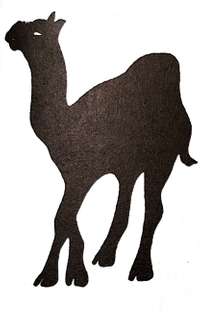INTRODUCING THE CAMEL, by Peter Grill. Lamar Witmer in Kenya sent us a copy of this unique book. He wrote, "I've read  a number of books about camels. The one I am sending you is the one I believe to be the most useful as a single guide for development workers among pastoralists who herd camels. It emphasizes practical concerns rather than purely scientific ones. It was written from the perspective of eastern Africa, which may limit its usefulness in other regions.
a number of books about camels. The one I am sending you is the one I believe to be the most useful as a single guide for development workers among pastoralists who herd camels. It emphasizes practical concerns rather than purely scientific ones. It was written from the perspective of eastern Africa, which may limit its usefulness in other regions.
"One of the problems is that it was printed by special project money in 1987 and only a limited supply remains." Well, we agreed that it was a practical and unique book that should be easily available. So it was reprinted by the Mennonite Central Committee Office in the USA for distribution by ECHO.
It is a 149-page, spiral bound book. Chapter titles include: habitat of camels; camel adaptations to heat stress; reproduction (reproductive habits, rutting behavior, signs of oestrus, oestrus cycle, coitus, pregnancy testing, parturition); raising camel calves; establishing a camel breeding herd; products from the camel (milk production, composition and products, meat, blood, hides and wool, misc.); the riding camel (uses, selecting, pace, selecting by age, training, handling, weight bearing, breaking the lead, riding saddle), camels as beasts of burden (potential uses, capacity, age for training, moving a camel train, loading a camel, types of baggage saddles, making a baggage saddle, draft camels, plowing with the camel, other uses as a power source); buying camels (marketing system, difficulties, selecting, determining the age); feeding and watering camels (eating habits, feeding management, watering, drinking rate); common camel health problems in Kenya (general health, signs of a sick camel, examining the camel, common health problems, diseases [protozoal, bacterial, viral, internal parasites, external parasites, other problems]); developing a record system.
An excerpt from the feeding chapter follows. "Camels are primarily browsers. This gives them an advantage over cattle because they will eat leaves from trees in addition to grass much more readily than cattle will. ... [This] makes them ideal animals to add to the livestock mix of commercial ranches. Some ranchers in Kenya have added camels to their cattle and small stock ranching system so that they can use the camels to open up new pasture areas for the small stock. In dense brush the camels are brought in to browse the bushes. This breaks up some of the dense brush so that the goats can come in and browse the lower branches. The goats thin out the foliage so that the sun can reach the grasses. The additional sunlight increases the growth of the grass so that the cattle and sheep have more to eat. ... they increase the carrying capacity of the land for cattle and sheep in addition to the meat and milk from camels who are eating what would normally be unused by the other stock."